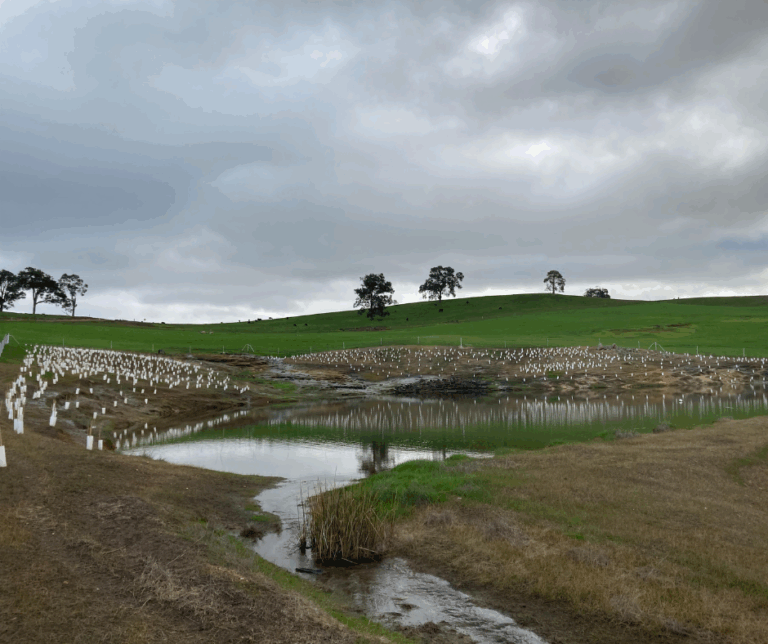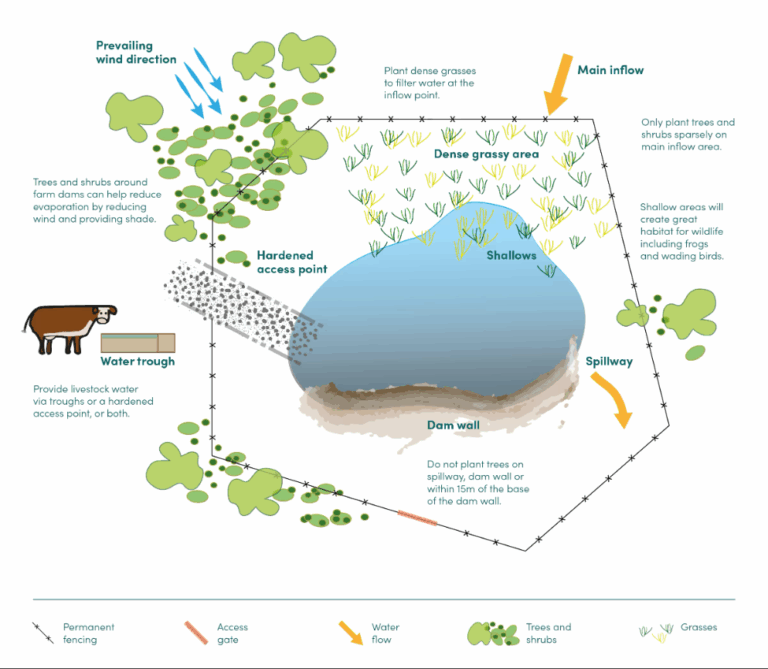
Enhanced farm dam as part of South West NRM’s FEaST 2030 project. Photo taken in July after planting and fencing.
Enhancing farm dams by fencing, pumping water to troughs and revegetating, is not only good for animal production but also one of the most important ways landholders can support biodiversity.
If you’re interested in revegetating your dam, here is some expert guidance from landcare legends Chris Howe (formerly Leschenault Catchment Council and Jenny Dewing (Blackwood Environment Society).
Getting started with enhancing farm dams
Chris has been a revegetation practitioner for the past 10 years, as well as volunteering on other projects in his spare time. He had some great words of wisdom for people doing reveg projects on a shoestring.
“Have a clear reason why you’re doing it because all the decisions you need to make along the process need to fall back on that reason,” Chris said.
Design phase
To help achieve your desired outcome and make it a good experience, Chris offered some questions to ask yourself in the design phase:
- Do you want it for recreation/aesthetic purposes or water quality for livestock?
- Is it for biodiversity? If so, what species do you want to attract?
- Will you need to drive livestock across it because you’ve got paddocks on both sides?
- Do you need vehicle access for management. What size is your equipment? Is there enough room to turn around or do you need an exit point as well?
- What are your budget, time and skill capabilities?
Considering how you plan to manage weeds and watering in the initial stages is also something to have in mind right at the start. And the way you manage it in the beginning doesn’t necessarily need to reflect how you want it to be managed in the long term.
For example, many attendees wanted their sites to be spray-free which is a fantastic goal for the established site, but herbicides and irrigation may be useful tools for being successful in the establishment phase.
“Managing the site is an important discussion to have right at the start, because these projects aren’t just about getting rid of the weeds, chucking a few plants in and you’ve got a forest. The ongoing maintenance is hugely important and will determine success or otherwise,” he said.
Jenny Dewing is an experienced reveg expert and said inspiration to enhance her dam came about through a desire for better water quality, which had been a management issue across the farm for decades. But because she also wanted to provide habitat for wildlife, design was critical.
“The more complexity you can get into the design the better. Try to make shallow edges and islands with gradual sloping sides, even if you’ve already got a dam, you can get in and do some retro-fitting,” she said.
“Work on the margins to create shallow wetlands which are really good for water birds. The more complex the dam is, with logs and other additions to create a diversity of habitats, the better the dam will be for wildlife.”
Planting the right plants in the right place
Chris and Jenny both discussed the different habitat niches in dams and how to choose the right species for each section.

Management interventions aimed at improving water quality. Taken from Dobes et al. 2021
Main inflow
This is where you begin slowing the water down and start to filter out the nutrients so that the water entering your dam isn’t full of sediment, animal manure, fertiliser run-off etc.
Those contaminants are what decreases the water quality of your dam, so stopping them with mass plantings of sedges, rushes and grasses is the general approach and a good place to start your revegetation process. Trees are typically not used here to avoid water erosion around the base of the trees.
See Plant Species List at end of article for suggestions.
Shallows/ dam margins
This zone can be tricky to plant due to fluctuating water levels throughout the year. Some areas will have roots submerged year-round, while others must endure dry summer conditions and wet feet in winter.
Different species will establish where conditions suit them the best. For best results, plant as the water level drops, following the receding edge. This ensures the soil is already moist, making planting easier and giving seedlings time to settle before they face waterlogging or drought.
Another effective method is to plant into sandbags filled with soil (without fertiliser) and place the entire bag in position, securing it with pegs or weights.
See Plant Species List at the bottom for guidance selecting plants for this section.
Dam wall
The dam wall is usually constructed deliberately, and the integrity of the wall is very important. For this reason Chris and Jenny both recommended shallow rooted species like grasses and reeds as tree roots could cause leakage.
Spillway
It’s important here not to impede or concentrate the flow of water in spillways, which can create erosion gullies. This is similar to the inflow zone. In fact it becomes the inflow zone for the next dam or body of water. So again, you’re looking at establishing 100% groundcover to slow down and filter the water. The overflow from the dam into the spillway should consist of a level sill to enable sheet flow into the spillway.
You can also add rocks here, but rocks should be appropriately sized (e.g. 300mm), completely cover the spillway and be battered on each side to avoid water concentrating between or around the rocks.
Surrounding terrestrial vegetation
Trees and shrubs provide important habitat above the high water mark around the dam while also reducing evaporation. Wider plantings using a mix of low shrubs and taller shrubs and trees make more effective windbreaks and habitat. Seek advice from your local Landcare group or nursery for advice on suitable species.
Ensuring access to water
While most fenced dams pump water to troughs, an alternative is to build a hardened (e.g. gravel) access point for livestock. This may also complement the pump system in case of failures or when nobody is able to check on animals’ access to water. Jenny also mentioned that in case of a fire, having an easy access for fire trucks can be very beneficial.
Planting large trees on the prevailing wind side will reduce wind evaporation off the dam and eventually create shade which will keep the water temperature lower, further reducing evaporation.
Chris recommends getting these in early as they take a while to grow. Flooded gums and Marri trees are a good local species to use.
Managing weeds
One of the most challenging weeds for revegetation is kikuyu.
“The issue is if you try and take it all out at once you’re setting yourself up for erosion problems so in a lot of cases you’re looking at managing it in small areas at a time to get other species established,” Chris shared.
“Generally, unless you’re actively managing it forever, it will come back. You can successfully have trees and shrubs with the kik growing up and through it.”
If you’re trying to avoid chemical control methods, steam weeding is good, although from a commercial perspective it’s not cheaper as it takes substantially more time in labour to be effective.
Chris recommends using grass selective herbicides which are safe to use around other plants.
“The benefits to grass-selectives is generally you’ll use them at lower rates, although be aware that they have longer residual times in the soil than glyphosate.”
Other techniques to reduce herbicide usage included cutting down the vegetative mass where possible either by slashing or small, cool burns. This will mean you only have to use a fraction of the herbicide dose to manage the regrowth. Chris also recommends getting dense plantings in and using trees to shade out weeds from growing underneath.
“The more trees and shrubs you grow, the more shade the kikuyu will have. It will be thin and wispy so there’ll be less management.”
Managing animal pests
A hungry animal can be devastating to a reveg site. Protecting your plants as they establish will avoid the heartache of coming back to your project and seeing all the plants pulled up by swamp hens or grazed by kangaroos and rabbits.
Tree guards can be used, although they begin to get expensive. Sometimes it can be more cost efficient to run chicken wire around bigger sections of plantings or invest in kangaroo fencing around the whole site. Fortunately in the South West snails and invertebrate pests tend not to be a problem and become increasingly less so as predator diversity starts to move in.
Concluding thoughts
Enhancing a farm dam is a long-term investment in water quality, biodiversity and the resilience of your farm.
By starting with a clear vision, thinking through your design, choosing the right plants for each zone, and planning for ongoing weed and pest management, you set your dam up to thrive for decades to come.
The rewards go beyond healthy livestock with a well-designed dam becoming a vibrant, self-sustaining ecosystem that benefits both your farm and the environment.
For more information, visit this link.
The FEaST 2030 project is supported by the Australian Government through funding from the Natural Heritage Trust under the Climate-Smart Agriculture Program and delivered by South West NRM, a member of the Commonwealth Regional Delivery Partners panel.
